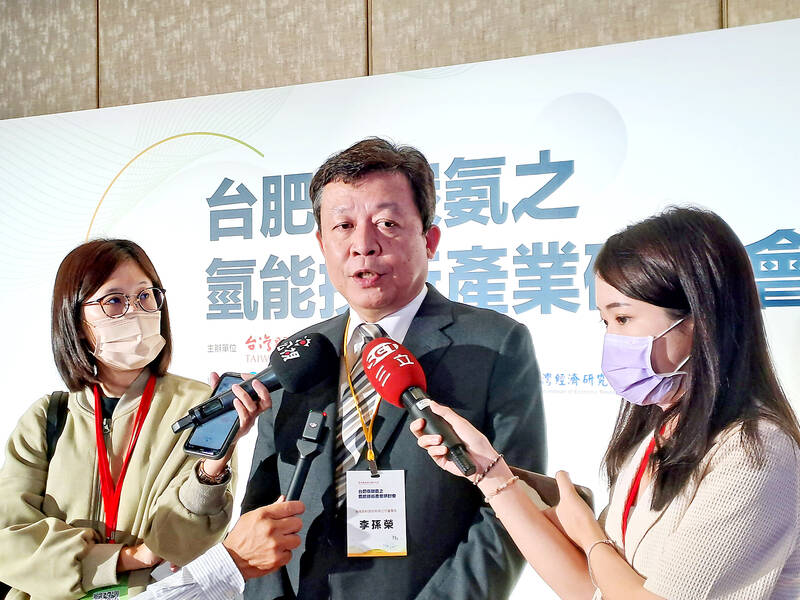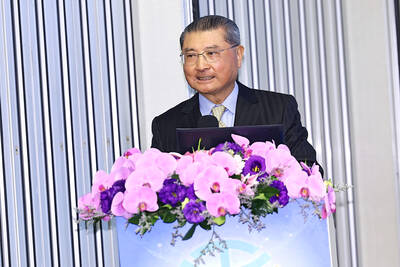Eyeing potential opportunities associated with low-carbon hydrogen, Taiwan Fertilizer Co (TFC, 台肥) is venturing into the clean energy sector by utilizing ammonia, an effective hydrogen energy carrier, TFC chairman Lee Suen-zone (李孫榮) said on Tuesday.
The company plans to construct two ammonia storage facilities over the next two to three years, Lee told an industrial seminar in Taipei.
Established in 1946, TFC is looking to transform its business to reduce carbon emissions in different ways, including a transition to clean energy using ammonia, traditionally a raw ingredient in fertilizer production, he said.

Photo: CNA
Lee also expounded on a technological breakthrough that would enable the company to use hydrogen and ammonia as renewable energy sources.
Ammonia is not only used for fertilizer production, but can also be used as an energy carrier and zero-carbon fuel, Lee said.
The chemical compound, made of hydrogen and nitrogen, does not emit carbon dioxide and can be mixed, or “cofired,” with coal at power plants to lower carbon emissions.
Ammonia can be directly broken down into hydrogen, making it a promising source of low-carbon energy, he said.
Low-carbon hydrogen includes green hydrogen (hydrogen produced from renewable electricity), blue hydrogen (hydrogen from fossil fuels using a process in which carbon emissions are reduced with the use of carbon capture and storage), and aqua hydrogen (hydrogen produced from fossil fuels via a new technology that does not emit carbon dioxide).
TFC currently has two ammonia storage facilities and plans to build two more in the next two to three years to meet the huge demand for ammonia as a low-carbon alternative to fossil fuels, Lee said.
The two existing ammonia storage tanks at the company’s Taichung plant have a total capacity of 40,000 tonnes per year and total annual shipments could reach 120,000 tonnes given a turnover ratio of three times per year, TFC acting president Chang Chang-lang (張滄郎) said.
The turnover ratio could still be raised to boost ammonia supply to the Taiwanese market, he added.
Developing hydrogen energy has become an important national goal, Lee said, adding that domestic hydrogen production is a better choice than importing it, because it can only be transported at an extremely low temperature, making importing difficult.
There is an emerging international consensus that a highly effective and cheap way to make hydrogen is through the conversion of ammonia, he said.
As the largest liquid ammonia supplier in Taiwan, TFC saw hydrogen development for the domestic clean energy market as a niche business and has invested in Al-Jubail Fertilizer Co, a joint venture with Saudi Basic Industries Corp in Saudi Arabia, to import ammonia from the country, Lee said.
Addressing the same seminar, Vice Premier Cheng Wen-tsan (鄭文燦) said he was upbeat about TFC’s ability to supply ammonia as a raw material for Taiwan Power Co (台電) to be cofired with coal, as a way of cutting carbon emissions.
Many countries around the world are developing hydrogen energy, one of the cleanest energy sources, as a substitute for oil and other fuels, he said, adding that as Taiwan moves toward the goal of net zero emissions by 2050, the establishment of a hydrogen supply chain is part of its hydrogen development strategy.

When an apartment comes up for rent in Germany’s big cities, hundreds of prospective tenants often queue down the street to view it, but the acute shortage of affordable housing is getting scant attention ahead of today’s snap general election. “Housing is one of the main problems for people, but nobody talks about it, nobody takes it seriously,” said Andreas Ibel, president of Build Europe, an association representing housing developers. Migration and the sluggish economy top the list of voters’ concerns, but analysts say housing policy fails to break through as returns on investment take time to register, making the

‘SILVER LINING’: Although the news caused TSMC to fall on the local market, an analyst said that as tariffs are not set to go into effect until April, there is still time for negotiations US President Donald Trump on Tuesday said that he would likely impose tariffs on semiconductor, automobile and pharmaceutical imports of about 25 percent, with an announcement coming as soon as April 2 in a move that would represent a dramatic widening of the US leader’s trade war. “I probably will tell you that on April 2, but it’ll be in the neighborhood of 25 percent,” Trump told reporters at his Mar-a-Lago club when asked about his plan for auto tariffs. Asked about similar levies on pharmaceutical drugs and semiconductors, the president said that “it’ll be 25 percent and higher, and it’ll

CHIP BOOM: Revenue for the semiconductor industry is set to reach US$1 trillion by 2032, opening up opportunities for the chip pacakging and testing company, it said ASE Technology Holding Co (日月光投控), the world’s largest provider of outsourced semiconductor assembly and test (OSAT) services, yesterday launched a new advanced manufacturing facility in Penang, Malaysia, aiming to meet growing demand for emerging technologies such as generative artificial intelligence (AI) applications. The US$300 million facility is a critical step in expanding ASE’s global footprint, offering an alternative for customers from the US, Europe, Japan, South Korea and China to assemble and test chips outside of Taiwan amid efforts to diversify supply chains. The plant, the company’s fifth in Malaysia, is part of a strategic expansion plan that would more than triple

Taiwanese artificial intelligence (AI) server makers are expected to make major investments in Texas in May after US President Donald Trump’s first 100 days in office and amid his rising tariff threats, Taiwan Electrical and Electronic Manufacturers’ Association (TEEMA, 台灣電子電機公會) chairman Richard Lee (李詩欽) said yesterday. The association led a delegation of seven AI server manufacturers to Washington, as well as the US states of California, Texas and New Mexico, to discuss land and tax issues, as Taiwanese firms speed up their production plans in the US with many of them seeing Texas as their top option for investment, Lee said. The